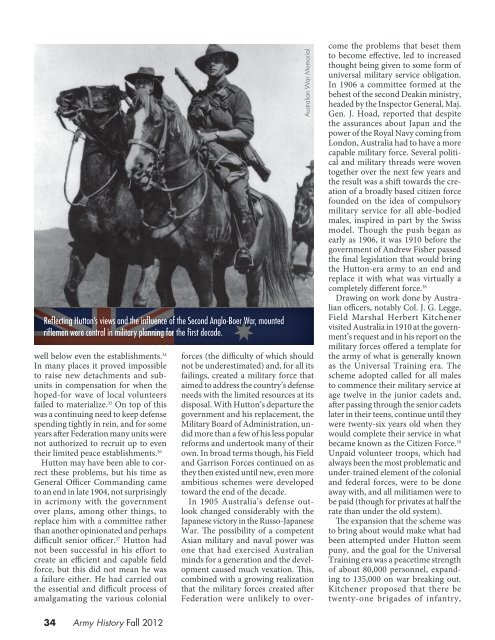Army History, Issue 85, Fall 2012 - US Army Center Of Military History
Army History, Issue 85, Fall 2012 - US Army Center Of Military History
Army History, Issue 85, Fall 2012 - US Army Center Of Military History
You also want an ePaper? Increase the reach of your titles
YUMPU automatically turns print PDFs into web optimized ePapers that Google loves.
Reflecting Hutton’s views and the influence of the Second Anglo-Boer War, mounted<br />
riflemen were central in military planning for the first decade.<br />
well below even the establishments. 34<br />
In many places it proved impossible<br />
to raise new detachments and subunits<br />
in compensation for when the<br />
hoped-for wave of local volunteers<br />
failed to materialize. 35 On top of this<br />
was a continuing need to keep defense<br />
spending tightly in rein, and for some<br />
years after Federation many units were<br />
not authorized to recruit up to even<br />
their limited peace establishments. 36<br />
Hutton may have been able to correct<br />
these problems, but his time as<br />
General <strong>Of</strong>ficer Commanding came<br />
to an end in late 1904, not surprisingly<br />
in acrimony with the government<br />
over plans, among other things, to<br />
replace him with a committee rather<br />
than another opinionated and perhaps<br />
difficult senior officer. 37 Hutton had<br />
not been successful in his effort to<br />
create an efficient and capable field<br />
force, but this did not mean he was<br />
a failure either. He had carried out<br />
the essential and difficult process of<br />
amalgamating the various colonial<br />
34 <strong>Army</strong> <strong>History</strong> <strong>Fall</strong> <strong>2012</strong><br />
Australian War Memorial<br />
forces (the difficulty of which should<br />
not be underestimated) and, for all its<br />
failings, created a military force that<br />
aimed to address the country’s defense<br />
needs with the limited resources at its<br />
disposal. With Hutton’s departure the<br />
government and his replacement, the<br />
<strong>Military</strong> Board of Administration, undid<br />
more than a few of his less popular<br />
reforms and undertook many of their<br />
own. In broad terms though, his Field<br />
and Garrison Forces continued on as<br />
they then existed until new, even more<br />
ambitious schemes were developed<br />
toward the end of the decade.<br />
In 1905 Australia’s defense outlook<br />
changed considerably with the<br />
Japanese victory in the Russo-Japanese<br />
War. The possibility of a competent<br />
Asian military and naval power was<br />
one that had exercised Australian<br />
minds for a generation and the development<br />
caused much vexation. This,<br />
combined with a growing realization<br />
that the military forces created after<br />
Federation were unlikely to over-<br />
come the problems that beset them<br />
to become effective, led to increased<br />
thought being given to some form of<br />
universal military service obligation.<br />
In 1906 a committee formed at the<br />
behest of the second Deakin ministry,<br />
headed by the Inspector General, Maj.<br />
Gen. J. Hoad, reported that despite<br />
the assurances about Japan and the<br />
power of the Royal Navy coming from<br />
London, Australia had to have a more<br />
capable military force. Several political<br />
and military threads were woven<br />
together over the next few years and<br />
the result was a shift towards the creation<br />
of a broadly based citizen force<br />
founded on the idea of compulsory<br />
military service for all able-bodied<br />
males, inspired in part by the Swiss<br />
model. Though the push began as<br />
early as 1906, it was 1910 before the<br />
government of Andrew Fisher passed<br />
the final legislation that would bring<br />
the Hutton-era army to an end and<br />
replace it with what was virtually a<br />
completely different force. 38<br />
Drawing on work done by Australian<br />
officers, notably Col. J. G. Legge,<br />
Field Marshal Herbert Kitchener<br />
visited Australia in 1910 at the government’s<br />
request and in his report on the<br />
military forces offered a template for<br />
the army of what is generally known<br />
as the Universal Training era. The<br />
scheme adopted called for all males<br />
to commence their military service at<br />
age twelve in the junior cadets and,<br />
after passing through the senior cadets<br />
later in their teens, continue until they<br />
were twenty-six years old when they<br />
would complete their service in what<br />
became known as the Citizen Force. 39<br />
Unpaid volunteer troops, which had<br />
always been the most problematic and<br />
under-trained element of the colonial<br />
and federal forces, were to be done<br />
away with, and all militiamen were to<br />
be paid (though for privates at half the<br />
rate than under the old system).<br />
The expansion that the scheme was<br />
to bring about would make what had<br />
been attempted under Hutton seem<br />
puny, and the goal for the Universal<br />
Training era was a peacetime strength<br />
of about 80,000 personnel, expanding<br />
to 135,000 on war breaking out.<br />
Kitchener proposed that there be<br />
twenty-one brigades of infantry,

















